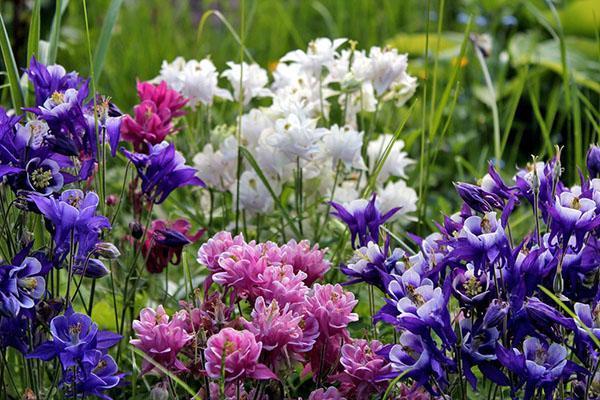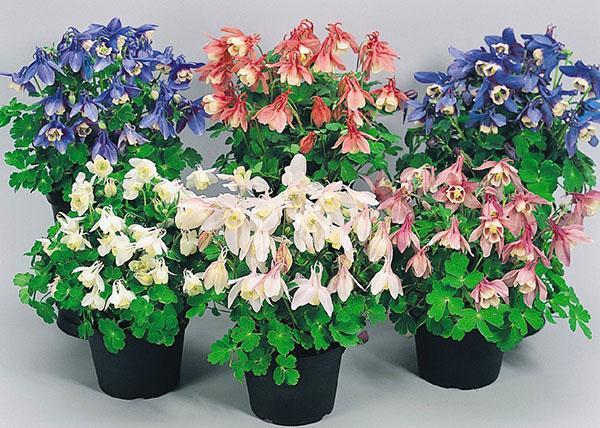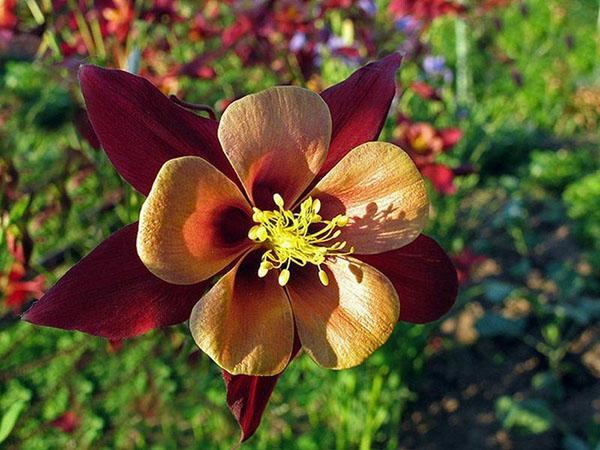The many-sided aquilegia: photo of flowers and description of species
 Aquilegia, photos of flowers of which you can see below, is a perennial herb that belongs to the Buttercup family. The distribution area covers Europe, America, Asia with temperate climatic zones. As for the name of the plant, there are several options for its origin. The first - as a translation from Latin, which means "collecting water". The second option is a connection with the word "eagle" - a bird of prey, whose sharp and curved claws in shape resemble the spurs of aquilegia flowers. There is also an opinion that the name of the flower was given by the ancient Germanic tribes, who called it the shoes of elves, forest magic spirits. The people call aquilegia a catchment area or an eagle. The British call the flower a dove, columbine, dove.
Aquilegia, photos of flowers of which you can see below, is a perennial herb that belongs to the Buttercup family. The distribution area covers Europe, America, Asia with temperate climatic zones. As for the name of the plant, there are several options for its origin. The first - as a translation from Latin, which means "collecting water". The second option is a connection with the word "eagle" - a bird of prey, whose sharp and curved claws in shape resemble the spurs of aquilegia flowers. There is also an opinion that the name of the flower was given by the ancient Germanic tribes, who called it the shoes of elves, forest magic spirits. The people call aquilegia a catchment area or an eagle. The British call the flower a dove, columbine, dove.
Description

Varieties
There are over 100 varieties of aquilegia. Of these, only 35 have been cultivated, and about 70 grow in the Northern Hemisphere. Consider the most popular varieties of the catchment area.
Aquilegia hybrid
 Most often in this species there are semi- and double varieties with an unusual structure that distinguishes them from other catchments. More than 5 flowers are formed on the plant, outwardly resembling an aster. This variety most often lacks a spur or is poorly developed.
Most often in this species there are semi- and double varieties with an unusual structure that distinguishes them from other catchments. More than 5 flowers are formed on the plant, outwardly resembling an aster. This variety most often lacks a spur or is poorly developed.
Aquilegia Nora Barlow
 It is the most famous hybrid eagle variety, named after Charles Darwin's grandmother and cultivated since the 17th century. The flowers have a pronounced doubleness due to the large number of corolla petals and rich shades. The plant is a sprawling bush with a diameter of up to half a meter and a height of up to 0.7 m. The main difference of the variety is the juicy green foliage, with towering white-pink buds.
It is the most famous hybrid eagle variety, named after Charles Darwin's grandmother and cultivated since the 17th century. The flowers have a pronounced doubleness due to the large number of corolla petals and rich shades. The plant is a sprawling bush with a diameter of up to half a meter and a height of up to 0.7 m. The main difference of the variety is the juicy green foliage, with towering white-pink buds.
Young growth from fallen seeds can be very different in appearance from the parent plant.
Terry aquilegia
 This variety also belongs to perennial forms. In the process of growth, a compact bush is formed, reaching 0.8 m in height.
This variety also belongs to perennial forms. In the process of growth, a compact bush is formed, reaching 0.8 m in height.
The plant is remarkable for its terry buds of an unusual shape up to 6-8 cm in diameter and many shades: pink, yellow, blue, white. Orlik is desirable to plant in shady areas, but if necessary, it can feel good in sunny areas. It is grown by seed, sowing into the soil in spring and autumn. It is widely used in mixborders, it is planted in heaps with other varieties, actively goes to cut.
Aquilegia ordinary
 It grows mostly in Scandinavia, Europe and America.A distinctive feature of the variety is a simple bud up to 5 cm in diameter. True, it is valued for the decorativeness of the flower itself, the petals of which are beautifully curved in the form of a cup, in the middle of which there is a spur of the same shade as the bud (some varieties have contrasting colors). Rolling up, the petals collect and retain rainwater or dew. This variety gave birth to numerous garden varieties that have flowers resembling clematis, openwork foliage or double buds.
It grows mostly in Scandinavia, Europe and America.A distinctive feature of the variety is a simple bud up to 5 cm in diameter. True, it is valued for the decorativeness of the flower itself, the petals of which are beautifully curved in the form of a cup, in the middle of which there is a spur of the same shade as the bud (some varieties have contrasting colors). Rolling up, the petals collect and retain rainwater or dew. This variety gave birth to numerous garden varieties that have flowers resembling clematis, openwork foliage or double buds.
Aquilegia Winky
 The variety is widely used in drawing up garden design, interior design (for example, when decorating balconies), in bouquets, often found as potted crops. During development, a small compact bush forms. On the stems, 25 cm long, there is a flower, collected in an inflorescence and having a wide color palette.
The variety is widely used in drawing up garden design, interior design (for example, when decorating balconies), in bouquets, often found as potted crops. During development, a small compact bush forms. On the stems, 25 cm long, there is a flower, collected in an inflorescence and having a wide color palette.
Aquilegia Columbina
 The variety belongs to perennials. Forms a compact bush up to 0.7 m high. The plant is cold-resistant, feels great in shading, which is very unusual for aquilegia. At the end of May-June, it dissolves buds up to 6 cm in diameter, collected in paniculate inflorescences. Most often, the variety is used for planting in resting places, in mixborders, group planting.
The variety belongs to perennials. Forms a compact bush up to 0.7 m high. The plant is cold-resistant, feels great in shading, which is very unusual for aquilegia. At the end of May-June, it dissolves buds up to 6 cm in diameter, collected in paniculate inflorescences. Most often, the variety is used for planting in resting places, in mixborders, group planting.
The plant looks good in a circle of irises, bells, ferns.
Aquilegia Biedermeier
 This is a hybrid variation based on a wild catchment. That is why the plant is resistant to external influences of nature and unpretentious in cultivation. In an adult state, the bush reaches only half a meter. On a long peduncle, beautiful double flowers of a hybrid shape with a unique two-tone color bloom. Most often it is a mixture of white and blue, yellow with red and purple with blue.
This is a hybrid variation based on a wild catchment. That is why the plant is resistant to external influences of nature and unpretentious in cultivation. In an adult state, the bush reaches only half a meter. On a long peduncle, beautiful double flowers of a hybrid shape with a unique two-tone color bloom. Most often it is a mixture of white and blue, yellow with red and purple with blue.
Aquilegia spurless
 It grows in Japan and China. The view is remarkable for its diminutiveness - the bush reaches only 0.2 m in height. The foliage of the plant is openwork, pink flowers bloom on the peduncles that do not have spurs. On the basis of this species, by crossing, many hybrids were bred, giving double and simple forms of flowers with a bush height of 8-120 cm. In this case, spurs can be in the bud, or they can be absent.
It grows in Japan and China. The view is remarkable for its diminutiveness - the bush reaches only 0.2 m in height. The foliage of the plant is openwork, pink flowers bloom on the peduncles that do not have spurs. On the basis of this species, by crossing, many hybrids were bred, giving double and simple forms of flowers with a bush height of 8-120 cm. In this case, spurs can be in the bud, or they can be absent.
Aquilegia Mac Canna
 Also a hybrid tall variety. Plant height reaches 1.2 m. Distinctive features are: the presence of a long spur, the absence of drooping buds, different colors of petals and sepals. Moreover, it is diverse and represented by all shades of the rainbow.
Also a hybrid tall variety. Plant height reaches 1.2 m. Distinctive features are: the presence of a long spur, the absence of drooping buds, different colors of petals and sepals. Moreover, it is diverse and represented by all shades of the rainbow.
Aquilegia blue
 Mostly grown in the United States. It can be identified by large, with long unbent spurs (5 cm), flowers (approximately 6 cm in diameter), located on rather high (up to 0.4-0.7 m) peduncles. The corolla is white, the sepals are pale blue with a slight lavender tint. The species has a huge variety of hybrids of different shades, including lemon.
Mostly grown in the United States. It can be identified by large, with long unbent spurs (5 cm), flowers (approximately 6 cm in diameter), located on rather high (up to 0.4-0.7 m) peduncles. The corolla is white, the sepals are pale blue with a slight lavender tint. The species has a huge variety of hybrids of different shades, including lemon.
Decorative qualities
 As you can see from the photo of flowers, aquilegia is a great option for creating landscape design... It goes well with conifers such as European spruce and Korean fir, creating a contrasting and light Mediterranean style. The catchment looks good near a decorative pond against the background of various coastal plants.
As you can see from the photo of flowers, aquilegia is a great option for creating landscape design... It goes well with conifers such as European spruce and Korean fir, creating a contrasting and light Mediterranean style. The catchment looks good near a decorative pond against the background of various coastal plants.
Aquilegia is also used on alpine slides, rockeries, flower beds. True, for them, you should carefully select varieties, taking into account the spreading and height of the bush, as well as the shade and time of bud blooming.
On average, flowering lasts about a month. With good care, it can increase up to 7 weeks.
Aquilegia is famous not only for the beauty of its flowers, but also for the decorative foliage. Having picked the right varieties, you can change the design of your site and give it sophistication and tenderness.